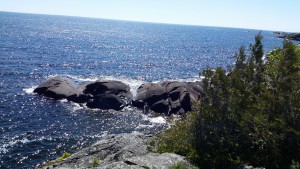 Recently I visited Pukaskwa National Park, the only wilderness national Park in Ontario. The Park features a small campground and 1878 square km of wonderful Northern Ontario natural heritage.
Recently I visited Pukaskwa National Park, the only wilderness national Park in Ontario. The Park features a small campground and 1878 square km of wonderful Northern Ontario natural heritage.
I had a wonderful time camping, exploring, and learning about the landscape at Pukaskwa. We were there prior to the official start of their interpretation season (July and August) but still managed to take in some activities and many of their trails have great interpretive signage that can be used without a guide.
Anishinaabe Camp Construction
The first morning at Pukaskwa we joined in a walk to the Anishinaabe Camp that was currently under construction. We were the only ones to participate in the walk that morning but it was worth the half hour to talk with the people building an interpretive space based on traditional knowledge. Our guide was from Pic River First Nation and works as at the park as a cultural interpreter and programmer and the builders were a combination of local and visiting people with knowledge of traditional structures. As an added bonus our guide took us into the Visitor Centre despite it not being officially open for the season so we could take a look at some of their other programming spaces and some of the other birch bark items that were made at the Park. I loved that the park integrates traditional knowledge keepers into interpretive programming.
Beach Trail
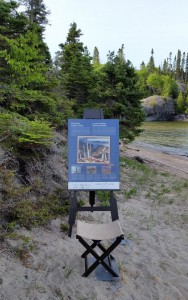 Pukaskwa has a number of short hikes that can all be completed in a hour or two from the campground. This was perfect for us given that we were traveling with a small child. The first hike we did was the “Beach Trail” which visits driftwood filled beaches in three different areas of shoreline – Horseshoe Bay, middle beach, and north beach. The views of Lake Superior and the huge amounts of driftwood were amazing to look at. This trail was a fairly easy hike though there were a few spots that could have used better signage and required some hunting to pick up the trail again. In addition to the natural beauty Horseshoe Bay also featured an easel which explored the Group of Seven’s paintings inspired by the landscape contained in Pukaskwa. I loved this integration of history, culture, and natural heritage.
Pukaskwa has a number of short hikes that can all be completed in a hour or two from the campground. This was perfect for us given that we were traveling with a small child. The first hike we did was the “Beach Trail” which visits driftwood filled beaches in three different areas of shoreline – Horseshoe Bay, middle beach, and north beach. The views of Lake Superior and the huge amounts of driftwood were amazing to look at. This trail was a fairly easy hike though there were a few spots that could have used better signage and required some hunting to pick up the trail again. In addition to the natural beauty Horseshoe Bay also featured an easel which explored the Group of Seven’s paintings inspired by the landscape contained in Pukaskwa. I loved this integration of history, culture, and natural heritage.
Bimose Kinoomagewnan
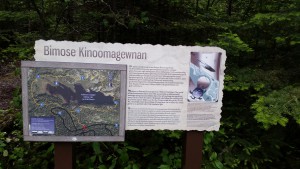
The second trail we explored was the Bimose Kinoomagewnan trail or the “Walk of Teachings”. This trail may have been my favourite of the many hikes we did at Pukaskwa. It didn’t have Lake Superior views but the views around Halfway Lake and the interpretive signage focusing on the Seven Grandfather Teachings was extremely well done.
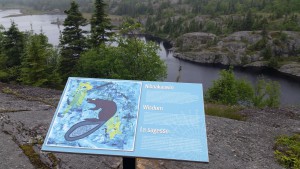
Each teaching had a sign placed at scenic points on the trail and the signage contained stories of Elders’ experiences in the park, their thoughts on the teachings, and their memories of the land. Each of these written experiences was paired with artwork by local youth. The signage was in three languages (English, French, Ojibway) and extremely well done and added to the trail significantly. On the natural heritage side of things I loved the variety of this trail which includes forested land, huge rock faces, hills, a beaver lodge, and fantastic views.
Southern Headland Trail
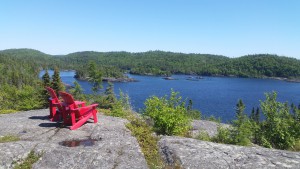
This was probably the most popular trail we explored – at least judging by the number of people we saw exploring the views. On many of the other hikes we didn’t see anyone else. The Southern Headland trail has breath taking Lake Superior views and overlooks Hattie Cove, Pulpwood Harbour, and Horseshoe Bay.
This walk provides visitors with glimpses of the power of Superior and there is some signage talking about the impact the lake has on the landscape and flora/fauna in the region. This trail also featured the “red chair experience” a Parks Canada national initiative which places red Muskoka style chairs at places with breathtaking views and spots which highlight some of the best spots in national parks. I love the idea of making destination points within parks that are points of connection, shared experience, and social media opportunities.
Manito Miikana
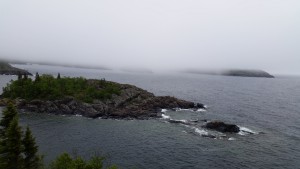
Also known as “the Spirit Trail”, Manito Miikana is a predominately forested trail leading to two viewing platforms with panoramic views of Lake Superior. This was by far the most difficult trail we hiked, it has a lot of changing elevations, a ton of tree roots, uneven ground, and it was very wet the day we walked it. The views were similar to that of the Southern Headland Trail but overlooked different portions of the lake and also allowed for a look at the Pic River Dunes in the distance. It wasn’t a bad hike and we probably would have enjoyed it more if it hadn’t rained so much prior to our walk.
Overall
I really enjoyed Pukaskwa National Park, exploring the natural history and learning a bit more about the landscape of the North Shore. I was also pleasantly surprised by a lot of the interpretation programming and signage in the park. The interpretation I engaged with was really well done and the Park has made an effort to engage local Indigenous communities in programming and include traditional knowledge in their signage.
